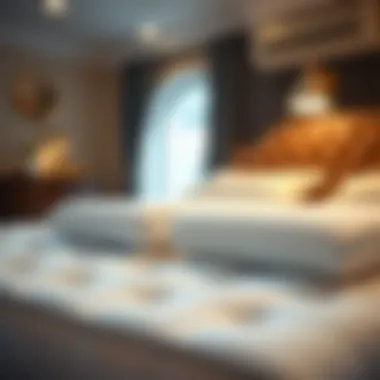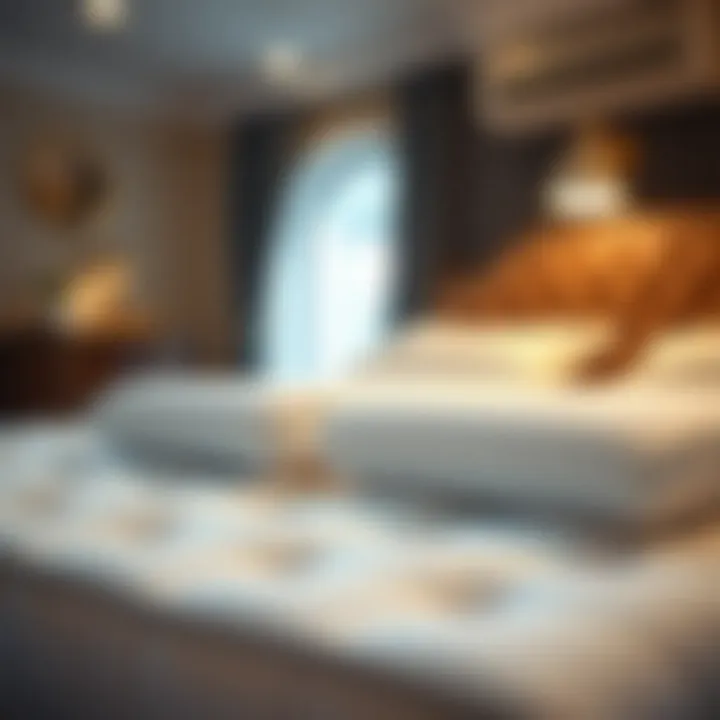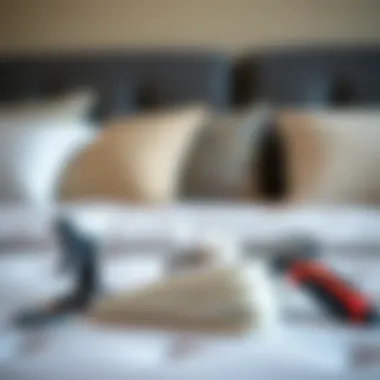The Essential Guide to Foam Topper Covers for Better Sleep


Intro
In the realm of home comfort, few items have surged in popularity as foam toppers. They offer an effortless way to enhance the feel of mattresses, marrying support with softness. However, the effectiveness of these foam toppers can significantly hinge on the quality of the cover protecting them. This guide provides homeowners and interior designers the lowdown on foam topper covers – analyzing the materials, features, and benefits that make them an essential addition to any sleep setup.
Foam toppers are not just mere accessories; they are investments in better sleep. A well-chosen cover prolongs the life of your topper, safeguarding it from daily wear, tear, and even the occasional spill. Moreover, the right cover can amp up comfort, providing a cozy barrier between you and the foam itself.
As we dive deeper into this guide, we will navigate through various aspects of foam topper covers. From understanding different materials to learning about maintenance tips, each section is designed to equip you with knowledge that translates into better choices for sleep quality. Let’s get going!
Understanding Foam Toppers
Foam toppers are becoming increasingly popular for homeowners looking to elevate their sleeping experience. Understanding these products is essential, as it links to comfort, support, and overall well-being. A foam topper can transform your mattress, mitigating back pain or simply adding an extra layer of softness. When you know what foam toppers are and how to choose the right one, you set the foundation for a better night's sleep.
What Are Foam Toppers?
Foam toppers are additional layers of foam placed on top of your existing mattress to improve its comfort level. Typically, they come in various thicknesses and densities, allowing for a customizable sleeping experience. These toppers can adapt to your body’s contours, providing support where it's most needed. The right topper can transform an uncomfortable mattress into a dreamy oasis for slumber.
Benefits of Using Foam Toppers
Using a foam topper can be a game changer. First and foremost, it offers affordability. Instead of shelling out for a new mattress, a topper offers a cost-effective way to upgrade your sleeping space. Additionally, foam toppers can help reduce joint and back pain by providing enhanced support. They can also add an extra layer of thermal comfort, with some materials designed to keep you cool or warm based on the season. In essence, a foam topper can enhance not just sleep quality, but overall health too.
Types of Foam Toppers
Different types of foam toppers cater to various needs and preferences. Let's take a look at the three main types:
Memory Foam
Memory foam is renowned for its ability to conform closely to the body. Its key characteristic is its viscoelasticity, meaning it can mold to a person’s shape while responding to heat and pressure. This makes it a popular choice among those seeking comfort and support. One unique feature of memory foam is its ability to relieve pressure points, which can help with pain management for side sleepers. However, the downside is that it can retain heat, making it less suitable for those who tend to sleep hot.
Latex Foam
Latex foam is derived from the sap of rubber trees. Its primary feature is its durability and natural resilience. This type of foam is popular for its eco-friendliness and hypoallergenic properties. Latex toppers often have a springy feel, providing excellent support while still being comfortable. One distinct advantage is their breathability; they maintain a cooler temperature during sleep. On the other hand, they can sometimes be heavier and more expensive than other options.
Polyurethane Foam
Polyurethane foam, or polyfoam, is a synthetic option that is widely used for its versatility. One of its key characteristics is its lightweight and adaptable nature, making it a common choice for those on a budget. Polyfoam can vary in density and firmness, so you can find options that cater to different preferences. A notable downside is that it may not be as durable as latex or memory foam, and it may not provide the same level of contouring support.
"Choosing the right foam topper can greatly influence your sleep experience, taking you from tossing and turning to restful slumber."
In summary, understanding foam toppers is not just about knowing what they are. It is about grasping the benefits, types, and how they can enhance your overall sleep quality. With the right foam topper, you're not just investing in comfort but also in improved health and well-being.
The Role of Foam Topper Covers
When it comes to enhancing the sleep experience, foam topper covers play a pivotal role that goes beyond mere aesthetics. They serve as the guardian of your investment while also adding layers of comfort that can transform an ordinary mattress into a plush sleeping oasis. Understanding the nuances of why foam topper covers are essential not only elevates your bed’s comfort level but also extends the longevity of the topper itself.
Purpose of Foam Topper Covers
Foam topper covers are designed for multiple important purposes. They are not just a protective layer; they bring a host of benefits that enhance the overall experience of using a foam topper.
- Protection from Wear and Tear: Foam toppers, while providing comfort, can also accumulate dirt and sweat over time. A cover acts as a buffer against such elements, preserving the integrity of the foam beneath.
- Facilitation of Cleaning: Most foam toppers can’t be washed directly. A cover allows users to easily remove, wash, and maintain hygiene without damaging the topper itself.
- Customization of Feel: Some covers are padded or made with various materials that can change how the topper feels. They give users the ability to tweak their sleeping surface, for instance, by adding a cooling effect or extra softness.
The importance of these covers cannot be overstated—they must be treated as essential components of your sleep system rather than mere accessories.
How Covers Enhance Comfort
Comfort is the name of the game when it comes to sleep quality. A well-chosen foam topper cover can significantly affect how that comfort is experienced by the sleeper. How?
- Temperature Regulation: Many modern covers are made with breathable fabric, allowing for better air circulation. This is key for people who tend to sleep hot. The right cover can wick away moisture while keeping the sleeper cool and dry.
- Reduction of Motion Transfer: In households where two or more people share a bed, a cover can help absorb motion. This means that if one partner shifts, the other may remain undisturbed, leading to a better night’s sleep.
- Softening Firmness: For toppers that might be too firm for some individuals, adding a soft cover can introduce a plush element that enhances comfort without sacrificing support.
In essence, a carefully selected cover acts like icing on the cake—it's vital for personal comfort and the overall sleep experience.
Protecting Your Investment
Investing in a foam topper is a step toward improved sleep, but neglecting to pair it with a quality cover can lead to premature wear. Here’s why you need to protect that investment:
- Durability: A good quality foam topper cover acts as a shield against stains and spills which can cause lasting damage. Accidental spills can be disastrous if the topper itself becomes soaked.
- Cost Efficiency: By preventing wear and tear, you’re saving yourself money in the long run. A quality cover can extend the lifespan of your topper significantly—it’s not just a purchase, but a wise investment.
- Enhanced Resale Value: Should you decide to switch to a new mattress or topper in the future, a well-maintained topper with an accompanying cover will retain its value better than one that looks worn out and shabby.


Ultimately, using foam topper covers demonstrates a level of care for your sleeping environment that pays dividends in comfort, longevity, and savings.
"The right cover can not only enhance comfort but can also significantly lengthen the lifespan of your foam topper, making it a worthwhile investment."
This understanding lays the groundwork for recognizing the importance of foam topper covers rather than viewing them as an afterthought in your sleep sanctuary.
Materials Used in Foam Topper Covers
Understanding the materials that comprise foam topper covers is crucial because it directly influences comfort, durability, and maintenance. The right material not only enhances your sleep experience but also contributes to extending the life of your foam topper. By choosing the appropriate fabric, you ensure that your investment is protected against wear and tear, while serving the diverse needs of your sleeping environment. In this section, we’ll delve into cotton, polyester, and bamboo fabric, each offering distinct benefits and considerations.
Cotton Covers
Cotton is often celebrated for its natural properties and widespread appeal. Its breathability is second to none, allowing air to circulate freely, which can help in regulating body temperature. This is particularly advantageous for those who tend to overheat at night.
When considering cotton covers for foam toppers, one must pay attention to the thread count. Higher thread counts typically indicate a denser, more durable fabric—something to keep in mind if durability is your priority. Additionally, cotton is hypoallergenic, making it an ideal choice for allergy-sufferers. However, while cotton has many advantages, it does require regular washing to maintain hygiene, which adds to the maintenance aspect.
"Cotton covers not only offer comfort but also help in keeping your foam topper dry and fresh."
Polyester Covers
Polyester covers have become increasingly popular due to their versatility and affordability. These synthetic fibers are resilient, giving them a longer lifespan compared to natural materials. Polyester is resistant to shrinking and stretching, meaning that the cover keeps its shape even after multiple washes. Furthermore, polyester fibers can wick moisture away, which helps in keeping you dry throughout the night.
One downside to polyester is that it may not be as breathable as cotton, thereby leading to a warmer sleeping surface. That said, many modern polyester covers are designed with advanced technology to enhance breathability. If you’re budget-conscious or seeking a cover that promises durability with minimal upkeep, a polyester option might be your best bet.
Bamboo Fabric
Bamboo fabric is rapidly gaining notoriety thanks to its sustainability and unique properties. Made from the pulp of the bamboo plant, it’s incredibly soft, often compared to silk. Furthermore, bamboo fabric is known for its natural antibacterial properties, making it an excellent choice for those concerned about cleanliness and allergens.
The eco-friendly aspect of bamboo fabric cannot be overstated. As a renewable resource, bamboo grows quickly without the need for harmful pesticides, reducing its environmental impact. Additionally, these covers are often moisture-wicking and thermoregulating, making them suitable for a variety of climates.
However, it is essential to take note of the manufacturing process as some bamboo fabrics undergo chemical treatments that may negate their eco-friendly advantages. Always look for organic bamboo options whenever possible.
In summary, each of these materials has its own set of benefits and may cater to different needs. Cotton covers excel in breathability but need frequent washing. Polyester covers are durable and easy to care for, while bamboo fabric offers a sustainable and soft sleep surface. Understanding these materials enables homeowners and designers alike to make informed choices when selecting foam topper covers.
Key Features to Consider
When it comes to enhancing the comfort and functionality of foam toppers, selecting the right cover isn't just an afterthought—it's essential. Understanding the key features of foam topper covers can significantly influence not only the longevity of the topper itself but also your sleeping experience. Here’s a closer look at three critical features that every homeowner, designer, retailer, or enthusiast should consider before making a purchase.
Breathability
The breathability of a foam topper cover is vital for maintaining comfort and regulating temperature during sleep. A breathable material allows air circulation, reducing heat retention, which can impact how restful your sleep is. If you’ve ever woken up feeling too hot and sweaty, you know how crucial this aspect is.
Natural fibers like cotton or bamboo tend to be more breathable compared to synthetic options. When shopping, it's wise to look for covers that specifically mention temperature regulation or moisture-wicking properties. These terms often signify that the material is designed to keep you cool and comfortable throughout the night.
- Benefits of breathability:
- Promotes a cooler sleep environment.
- Reduces moisture accumulation, preventing mold and bacteria growth.
- Enhances overall comfort.
Don’t skimp on breathability—consider it a must-have for a truly revitalizing night’s rest.
Water Resistance
Next up is water resistance. Life is unpredictable; spills and accidents happen, and that’s where water-resistant covers come into play. A cover that can repel liquid protects your foam topper from stains and odors, extending its lifespan.
Water-resistant materials create a shield against moisture, ensuring easy cleanup without compromising the integrity of the foam below. This is especially pertinent if you have kids or pets roaming your home.
- Importance of water resistance:
- Defends against spills and accidents.
- Makes cleaning hassle-free.
- Reduces the risk of pungent odors.
If you're considering a long-term investment in your sleep environment, choosing a cover with these properties may save you plenty of headaches down the line.
Hypoallergenic Properties
Lastly, online shopping should lead you to explore hypoallergenic properties. For individuals with allergies or sensitivities, having a cover that resists dust mites, mold, and other allergens is paramount.
Hypoallergenic materials often use tighter weaves or special treatments that inhibit allergen accumulation. This means fewer sneezes and more peaceful nights.


- Why hypoallergenic covers matter:
- Provides a healthier sleep environment.
- Reduces allergens that could trigger discomfort.
- Essential for anyone with asthma or respiratory conditions.
When making a choice, consider this feature a priority if you or a loved one has allergies. It’s not just about comfort—it’s about health and well-being.
"A good night’s sleep can change your life, and the right foam topper cover plays a crucial role in achieving that serenity."
Choosing the Right Foam Topper Cover
Selecting the right foam topper cover is not just a matter of aesthetics; it's a crucial decision that can significantly influence the performance and lifespan of your foam topper. From fit to style, even cost, every detail matters in ensuring that your sleeping environment is both comfortable and functional. Taking the time to deliberate these factors allows you to make a choice that enhances your nightly rest rather than detracting from it. Here are elements to consider when diving into the world of foam topper covers.
Sizing Considerations
When choosing a cover, the size is paramount. A snug fit ensures that the cover does not bunch up during use, which can lead to discomfort. If it's too loose, you may experience shifting, potentially damaging the foam itself.
- Measure Your Foam Topper: Start by measuring not just the length and width, but also the thickness of your topper. This ensures you’re selecting a cover that fits perfectly.
- Standard Sizes: Familiarize yourself with the different mattress sizes (twin, full, queen, and king) since most covers are designed to fit these dimensions. However, custom sizes may also be available for unique toppers.
- Check Elasticity: Some covers come with elastic corners or straps, providing extra stability and helping the cover stay in place.
Ensuring that your cover fits like a glove keeps your foam topper in top shape, maximizing its comfort and longevity.
Style and Aesthetic Preferences
Once you've nailed down the size, the cover's style becomes the next important aspect. A foam topper cover isn't just about function: it also contributes to the overall aesthetic of your bedroom.
- Color Options: Choose colors that either complement or contrast your bedding for a cohesive look.
- Patterns and Textures: Floral prints or geometric patterns can add personality to your space. Textured fabrics may also enhance not just the look but the feel, creating a plush atmosphere.
- Material Visuals: From cotton to bamboo, the material can influence the overall appearance of your bed setup. Opt for materials that echo your personal taste and lifestyle.
Price Range and Budgeting
Financial aspects are hard to ignore when selecting the right foam topper cover. A decent cover doesn’t have to break the bank, but investing a bit more might pay off in terms of durability and comfort.
- Budget for Quality: Generally, better materials and craftsmanship come at a premium. Think about how much you’re willing to spend balanced against the quality and features you expect.
- Price Comparison: Check various retailers and compare prices online. Seasonal sales or discounts can help you snag good deals without compromising quality.
- Prioritize Features: Sometimes, it’s worth allocating more towards specific features like hypoallergenic materials or water resistance, particularly if you have allergies or pets.
Finding a cover that fits your budget while still ticking all your boxes can set you up for both comfort and savings.
"The right foam topper cover is an investment not just in comfort but in the overall quality of sleep, which ultimately impacts your daily performance."
Maintenance of Foam Topper Covers
When it comes to foam topper covers, maintaining their condition is paramount for prolonging the life of the foam underneath. Neglecting upkeep can lead to reduced effectiveness, compromised hygiene, and discomfort during sleep. Regular maintenance doesn't just improve the longevity of your topper cover; it also enhances your overall sleep quality while ensuring your sleeping environment remains healthy. This section will explore the essential aspects of maintaining your foam topper covers, such as cleaning instructions, stain handling, and determining when it's time to replace the cover.
Cleaning Instructions
The cleanliness of your foam topper cover is crucial. Not only does it contribute to better health and hygiene, but it also directly impacts the comfort of your sleep. Regular cleaning can help minimize allergens and dust mites that may accumulate over time. Here are some helpful steps to clean your foam topper cover effectively:
- Check the Care Label: Always start by checking any care instructions provided by the manufacturer. This can save you a lot of hassle and prevent you from accidentally damaging the material.
- Vacuuming: Use a handheld vacuum or an upholstery attachment on your vacuum cleaner to gently remove dust and crumbs. Lightly go over the surface to avoid damaging the material.
- Spot Cleaning: For small stains, mix a few drops of mild detergent with water, dab a cloth in the solution, and gently rub the stain. Avoid soaking the foam cover; too much moisture can lead to mold or mildew.
- Air Drying: After cleaning, it’s essential to let your topper cover air dry completely. Place it in a well-ventilated area away from direct sunlight, as excessive heat can harm the material.
- Wash Occasionally: Depending on the fabric and usage, machine washing may be possible. Ensure the cover is machine washable and use a gentle cycle.
Handling Stains
Stains on foam topper covers can occur for various reasons—spills, sweat, or simple wear. Immediate attention to stains can prevent them from becoming permanent. Here are some practical methods for managing stains:
- Immediate Dab: As soon as a spill occurs, quickly use a clean, dry cloth to dab the area. Avoid rubbing, as this can spread the stain or embed it deeper into the fabric.
- Homemade Solutions: For general stains, a mix of vinegar and water can be effective. Use a spray bottle to lightly mist the stain, and gently blot it with a cloth.
- Baking Soda for Odor and Stains: If there's an odor or tough stain, sprinkle baking soda on the area. Let it sit for several hours (or overnight) and then vacuum to remove it.
- Professional Cleaning: If all your homemade attempts fall flat, considering professional cleaning might be best. Especially for covers made of delicate fabric or for tough stains that seem beyond repair.
When to Replace Your Cover
Like most things in life, foam topper covers have a lifespan. Knowing when to replace them is vital to maintaining an effective and hygienic sleeping space. Here are some signs that it may be time to get a new cover:
- Visible Wear and Tear: If you notice frayed stitching, faded fabric, or significant discoloration, it’s probably time for a change.
- Persistent Odors: If any cleaning attempts fail to get rid of bad smells, your cover may need replacing.
- Allergic Reactions: If you've started sneezing or experiencing more allergies while using your topper, this may indicate accumulated dust mites or other allergens, meaning it’s time to move on.
- General Discomfort: If your sleeping experience isn’t as pleasant as it used to be, a new cover may restore that cozy feeling.
Regular maintenance of foam topper covers not only protects your investment but also encourages a restful night’s sleep. By following these cleaning, stain-handling, and replacement guidelines, you can ensure that your foam topper serves its purpose effectively, delivering comfort and support for a good night’s rest.
Environmental Considerations
When considering foam topper covers, engaging with environmental aspects shouldn’t be left to the back burner. As awareness about sustainability cruises through every facet of consumer goods, foam topper covers are not exempt from scrutiny. The materials we choose, how they’re produced, and their eventual disposal significantly reflect our values toward the planet. In this section, we delve into sustainable materials and eco-friendly certifications, both of which are crucial for conscientious homeowners, designers, and retailers.
Sustainable Materials


Sustainable materials are essentially those that are sourced in an environmentally friendly manner, without depleting resources or causing long-term damage to ecosystems. In the world of foam topper covers, several options stand out:
- Organic Cotton: Unlike conventionally grown cotton, organic cotton is cultivated without harmful pesticides. This not only safeguards the soil and water but also supports biodiversity.
- Recycled Polyester: This material, derived from recycled plastics, minimizes waste while maintaining durability. It’s particularly important as it helps reduce the plastic burden on our landfills and oceans.
- Bamboo Fabric: Obtained from the bamboo plant, this fabric is rapidly renewable. It naturally resists bacteria and requires fewer chemicals in its production process, marking it as a smart choice for eco-conscious consumers.
Choosing sustainable materials not only reduces the carbon footprint but also promotes healthier indoor air quality, especially for those sensitive to chemicals and allergens. It’s like hitting two birds with one stone—eco-friendliness and wellness go hand in hand.
Eco-Friendly Certifications
When weaving through the myriad of options for foam topper covers, eco-friendly certifications can act as a reliable compass. These certifications ensure that products meet certain environmental standards, providing peace of mind to consumers. Understanding these certifications helps in distinguishing genuinely environmentally friendly products from those merely marketed as such.
- Global Organic Textile Standard (GOTS): This certification is awarded to textiles created from organic fibers. It ensures that the entire supply chain is environmentally responsible and socially sustainable.
- OEKO-TEX Standard 100: This certification confirms that the fabrics are tested for harmful substances, ensuring they are safe for human use, thus indirectly benefiting the environment by promoting safer manufacturing processes.
- CertiPUR-US: Focused on polyurethane foam, this certification guarantees that the foam is made without harmful chemicals such as heavy metals or ozone depleters.
By opting for products that carry these certifications, consumers can contribute to an ecosystem that values health, both personal and planetary.
"Every eco-friendly choice is a step toward a more sustainable world. It’s all about weaving our values into the fabric of everyday life."
In summary, taking a step back to think about the environmental footprint of foam topper covers isn’t just a trendy notion, but a necessary shift toward a more sustainable lifestyle. This consideration touches on how we choose materials and what certifications we prioritize, ultimately weaving an interconnected story of comfort and conscience.
Comparative Analysis of Popular Brands
When it comes to choosing the right foam topper cover, understanding the landscape of available brands is crucial. Each brand presents its own set of benefits, materials, and price ranges. This comparative analysis aims to highlight critical elements such as durability, comfort level, and customer feedback. A thorough comparison helps consumers make informed decisions and find the best products suited to their needs.
Brand A Overview
Brand A has garnered a loyal fan base thanks to its commitment to quality. Their foam topper covers are primarily made from breathable cotton, ensuring a comfortable sleep experience. The covers are designed with meticulous attention to detail, featuring reinforced stitching to enhance durability.
One noteworthy aspect is the brand's impressive variety of sizes, catering to all types of mattresses. Various customer reviews often rave about how easy these covers are to clean, making them a practical option for busy households. Despite a slightly higher price point, many believe the investment pays off in terms of longevity and performance.
Brand B Comparison
On the other hand, Brand B takes a slightly different approach, focusing on affordability without compromising on quality. Their covers typically utilize a polyester blend, which appeals to budget-conscious shoppers. This brand focuses heavily on versatile designs, often releasing seasonal colors to match different bedroom aesthetics.
Interestingly, Brand B also incorporates advanced moisture-wicking technology, which has been particularly popular among customers who tend to sweat at night. User feedback highlights the effectiveness of these covers in maintaining a comfortable sleeping temperature. However, some critiques mention that the material might feel less luxurious than higher-end alternatives.
Brand Insights
Brand C positions itself in the eco-friendly market, making it a standout option for environmentally conscious consumers. Their foam topper covers are primarily crafted from sustainable materials, such as bamboo fabric and organic cotton. This not only helps the planet but also appeals to those concerned about allergens.
In addition to its green credentials, Brand C is noted for its superior softness and sumptuous feel. Customers often express satisfaction with the plush comfort provided by these covers. However, the price range is generally higher, which might deter some consumers. It’s crucial to weigh the benefits against the costs when considering this brand.
In summary, understanding the strengths and weaknesses of each brand can significantly influence your purchasing decision. Whether you prioritize eco-friendliness, comfort, or price, assessing each brand individually helps identify the best option for your foam topper needs.
Future Trends in Foam Topper Covers
As we look into the horizon of sleep innovation, staying abreast of emerging trends in foam topper covers becomes essential. This segment is more than mere speculation; it highlights advancements that can enhance comfort and overall sleep quality. Homeowners, designers, and retailers alike must cultivate an understanding of these trends to navigate the ever-evolving landscape of sleep solutions effectively.
Innovative Materials
The future of foam topper covers is increasingly marked by the introduction of innovative materials designed to enhance performance and comfort. One material that’s catching considerable attention is graphene. This wonder material not only boasts excellent thermal regulation but also helps wick away moisture effectively. Imagine a sleep surface that remains cool and dry throughout the night. Not only does this lead to improved comfort, but it can also significantly enhance the longevity of your foam topper.
Another material gaining traction is Eucalyptus Lyocell. This sustainable fabric brings forth natural softness and moisture-wicking properties, translating into a fresher and more breathable rest. It manages to cradle the sleeper in a cocoon of comfort without the need for harsh chemical treatments, making it attractive for those focused on eco-friendly choices.
- Benefits of Innovative Materials:
- Enhanced comfort through better thermoregulation
- Improved moisture management, keeping bedding fresh
- Sustainable options appealing to environmentally-conscious consumers
"Embracing innovative materials isn’t just about comfort; it reflects a growing awareness of environmental responsibility."
Additionally, advancements in biodegradable foams are on the increase. As consumers become more environmentally aware, the demand for products that pose less risk to nature is at an all-time high. Brands are now experimenting with formulations that break down more naturally without compromising on comfort, blending eco-friendliness with luxury.
Technological Advancements
Technology is playing a pivotal role in shaping the future of foam topper covers. The rise of smart technology embedded in these products offers possibilities that were once relegated to science fiction. Imagine topper covers equipped with sensors that can adjust their firmness based on your sleeping position or body temperature. Companies are starting to explore how incorporating these features could revolutionize the way we think of sleep comfort.
Another noteworthy advancement is the utilization of antimicrobial treatments. With health and hygiene becoming more prominent in consumers' minds, having covers treated with technology that inhibits the growth of bacteria and allergens is not just a selling point but a necessity for maintaining a healthier sleeping environment.
- Benefits of Technological Advancements:
- Adjustable comfort tailored to individual preferences
- Enhanced health protection through antimicrobial properties
- Increased awareness fostering a demand for tech-savvy solutions
It’s also important to note the role of smart fabrics which can actively respond to environmental conditions. These responsive materials adapt their characteristics based on heat and humidity levels, promising an unparalleled level of comfort.
As we head into this future, embracing emerging technologies in foam topper covers may not just be a trend, but a fundamental shift in how we think about and invest in our sleep quality.















